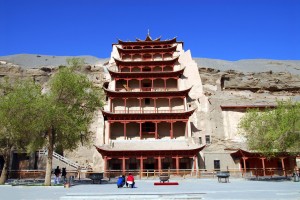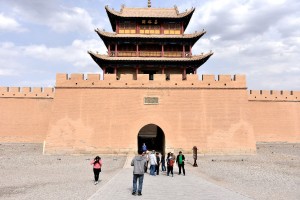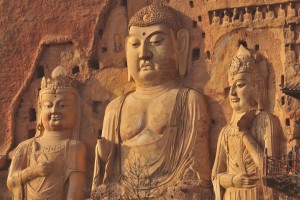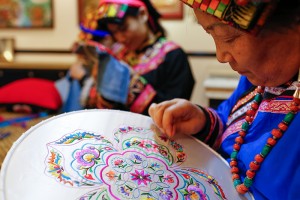 The Silk Road
The Silk Road
Throughout history, Gansu has been a crucial player in the development of Chinese civilization. Without Gansu, the Silk Road would not have been complete. This historic route facilitated trade and cultural exchange between the East and West, profoundly influencing the integration of human civilization. Gansu was the largest foreign trade gateway in ancient China along the Silk Road. Porcelain, silk, tea, and medicinal materials from the Central Plains were transported from the Western regions and Central Asia to the west coast of the Mediterranean through the Silk Road. Buddhism, walnuts, grapes, musical instruments, spices, and more were also brought back to China. Gansu is a significant location along the Silk Road, with numerous sites and cultural relics related to the ancient trade route, such as the Dunhuang Grottoes and Jiayuguan Pass.
The Dunhuang Mogao Grottoes are a UNESCO World Heritage Site and a significant treasure of ancient Chinese art. Plenty of precious murals, Buddha statues, and cultural relics are preserved here, demonstrating the essence of ancient Chinese art and Buddhist culture. And Jiayuguan is a significant pass of ancient China’s Silk Road, and one of the starting points of the Great Wall. There are well-preserved ancient city walls and fortresses, which have historical significance and tourism value. These sites bear witness to the historical exchanges between the ancient Chinese and Western cultures.
World Cultural Heritage - Dunhuang
 The Dunhuang Mogao Crottoes
The Dunhuang Mogao Crottoes
Dunhuang is a stronghold along the ancient Silk Road, representing the rich traditional culture of the Huaxia civilization and various Chinese ethnic groups. It is a significant site on the ancient Silk Road, serving as a treasure of Chinese civilization and showcasing the exceptional traditional culture of the Chinese nation. Additionally, it is a globally renowned world cultural heritage site. Dunhuang is a significant meeting place for four major cultural systems of the world: China, India, Greece, and Arabia. It marks the first stop of Buddhism's eastward entry into the Central Plains and serves as a convergence point for the three major religions of the world. The Mogao Grottoes in Dunhuang are the largest existing grotto site in China. It is a treasure house of Buddhist art with a long history and relatively complete preservation in the world. The site represents the high achievement of Chinese Buddhist art from the 4th to the 14th century AD and is one of the two cultural relics that meet all six standards of World Cultural Heritage. Dunhuang, a famous tourist destination on the Silk Road, is an iconic business card of Chinese tourism.
Great Wall Culture - the West Starting Point of the Great Wall
 The Jiayuguan Pass
The Jiayuguan Pass
The World Cultural Heritage Great Wall, which starts from Hushan in Liaoning Province in the east and ends at Jiayuguan Pass in Gansu Province in the west, passes through Liaoning, Hebei, Tianjin, Beijing, Inner Mongolia, Shanxi, Shanxi, Ningxia, Gansu, and Qinghai provinces, municipalities and autonomous regions. It is a wonder in the history of world architecture. The Great Wall was first built by the State of Chu in the 7th century B.C., with a history of more than 2,000 years, it has become a symbol of the Chinese nation's self-reliance, self-reliance, self-confidence, unity and unity. The Great Wall was first built by the State of Chu in the 7th century B.C., with a history of more than 2,000 years, it has become a symbol of the Chinese nation's self-reliance, self-reliance, self-confidence, unity, and unity. “Not to the Great Wall is not a true man,” the Great Wall has become a place of patriotic education and, tourism resort.
The World Cultural Heritage of the Great Wall -- Jiayuguan Pass (part), is now a national 5A tourist scenic spot, a national key cultural relics protection unit -- Jiayuguan Scenic spot, including Jiayuguan Guan City, the first pillar of the Great Wall, the hanging wall Great Wall, Heishanxia.
Buddhist Cultural Journey Along the Silk Road in Gansu
 The Buddhist grottoes
The Buddhist grottoes
Buddhist grottoes in Gansu, stretching from the western to the eastern bank of the river, resemble a radiant pearl nestled along the "Silk Road." These grottoes vividly showcase the brilliance of Buddhist culture in Gansu at that time, present in every significant juncture of the golden section of Gansu. According to statistics, there are more than 70 Buddhist grottoes along the Silk Road in Gansu. In addition to the world cultural heritage of Dunhuang Mogao Grottoes, there are other famous grottoes like Maiji Mountain, Yongjingbing, and Yulin Grottoes in Guangzhou. There are also many Buddhist temples in Gansu, such as Labrang Temple, the world's largest Tibetan academic institution, Dayun Temple, Jingchuan Dayun Temple, a national 4A tourist attraction, and Shandan Dayun Temple, which is praised as "the first Buddha in the world" by senior people in the Buddhist circle at home and abroad.
Gansu Yellow River Style Tour
 The Yellow River
The Yellow River
The Yellow River is the mother river of the Chinese nation and the cradle of Chinese civilization. With a length of 5,494 kilometers, the Yellow River is the second longest river in China after the Yangtze River and the fifth longest river in the world. Jiuqu Yellow River around Longyuan, forms a unique style of the Yellow River in Gansu, attracting countless visitors to explore the footprints of history. The Yellow River, with its broad and flexible mind, nurtured the ancestors of the Yellow River civilization, absorbed and integrated the essence of civilizations in various regions, and formed representative cultures such as Dadiwan culture, Yangshao culture, Qijia culture, Majiayao culture, Zhongyuan Longshan culture, Dawenkou culture, and Shandong Longshan culture, which became the mainstream of early Chinese civilization. Gansu, as an important part of the Yellow River Basin, carries a rich cultural heritage. On this land, the ancient Yellow River culture has been inherited and developed, leaving many precious historical sites. The scenery along the way is beautiful, and the magnificent Yellow River waters glow golden under the sunlight, which makes people feel relaxed and happy.
Folk Culture - into the Longyuan Land, Experience the Characteristics of Customs
 The Embroidery culture
The Embroidery culture
Gansu folk culture is colorful and distinctive. At present, Gansu Province has two folk cultures, including Gansu flowers and Gannan Tibetan opera, listed in the world’s intangible cultural heritage; Fifty-four folk cultures have been included in the National Intangible Cultural Heritage list. Gansu Huaer, the world's intangible cultural heritage, has a history of more than 400 years. It is a form of folk music sung by the working people in Linxia, Dingxi, Gannan, and other areas of Gansu Province to express their pursuit of ideals and love for a happy life. It has a strong flavor of life and local characteristics. There are various forms of singing, there are solo, duet, and chorus, especially the group duet is quite interesting, each composed of four or five singers, the two sides of the duet, the witty and vivid “Huaer” duet, which is very attractive. The collective duet has gradually evolved into a “Huaer meeting” with a relatively fixed time and place, which is held spontaneously by various ethnic groups.




































